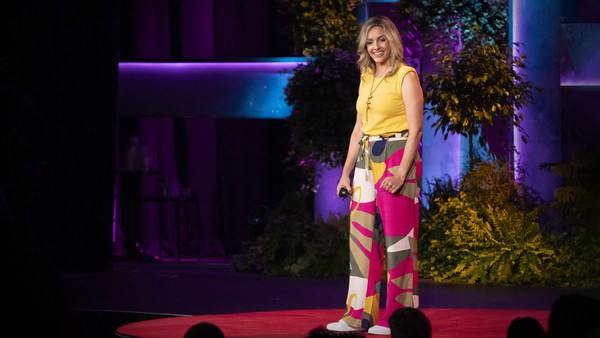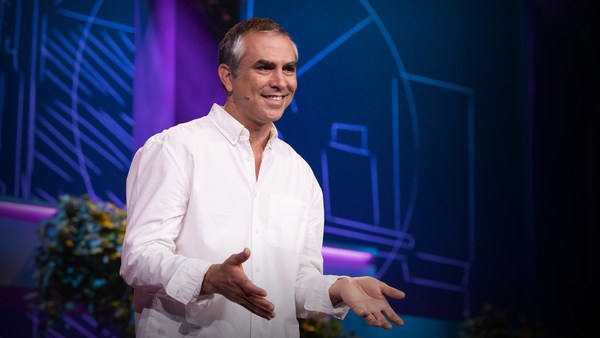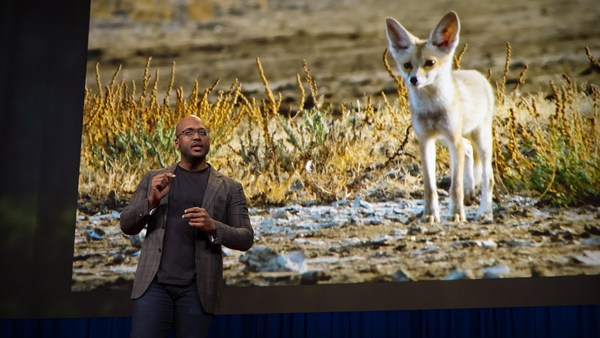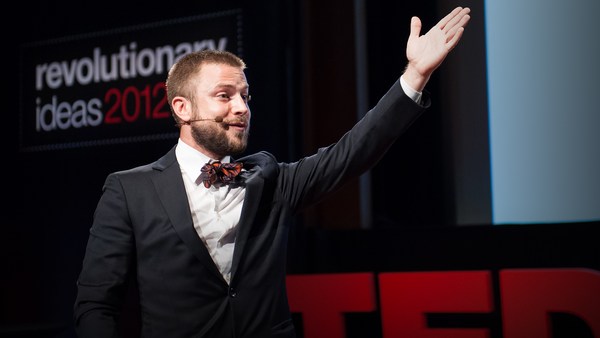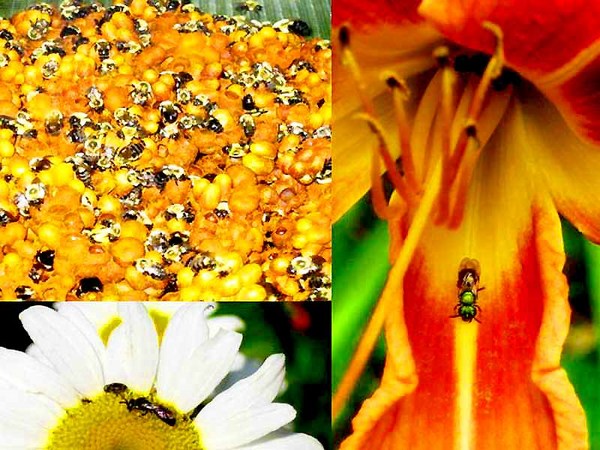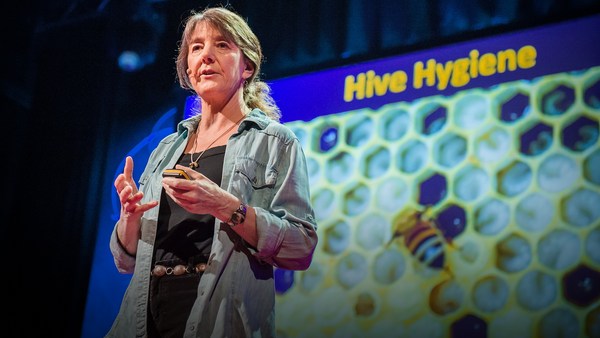So full disclosure, I am the nerdiest gardener you are ever going to meet.
(Laughter)
Technically, I'm an ecological horticulturalist, which is a fancy way of saying that I design and manage gardens that are extravagantly beautiful while also providing habitat for plant populations, wildlife communities and even soil organisms. And you might wonder, isn't that what all gardeners do? Unfortunately, no. The vast majority of gardens are ecological deserts, and in fact, an incredible amount of environmental damage has been done in the name of making pretty gardens. In the US alone, we dump over 100 million pounds of insecticides, herbicides and synthetic fertilizers on our lawns and gardens every year. There just isn't a garden pretty enough to be worth all of that, and the reality is that it's completely unnecessary.
Gardens and landscapes that are absolutely gorgeous can also help the world around us. They can provide food, water,and shelter to wildlife. Gardens can and have brought back plants and animals from the brink of extinction.
There is a movement happening all over the globe. Gardeners, garden designers, landscape architects, even entire cities are finding ways to beautify our environment while making space for the animals we share this land with. I've seen biodiversity return to one of the toughest places to live on the entire planet: the middle of New York City,
(Laughter)
where I cared for, designed and helped build public parks and gardens.
(Applause)
At Brooklyn Bridge Park, where I was director of horticulture, we took these massive derelict shipping piers out over the water between Brooklyn and Manhattan and turned them into an 85-acre post-industrial public park.
(Applause)
It was designed by MVVA and built out over a decade. And it's hard to imagine now, but this lush landscape was built on parched concrete. This is about as appealing to wildlife as a parking lot. And yet, just a few years after construction, we welcomed migratory birds, rare insects and clouds of butterflies, all among millions and millions of park visitors. When people go to Brooklyn Bridge Park, they're usually there to play basketball or have a picnic. They have no idea that they're walking through a monarch habitat or a firefly sanctuary. It just reads as a beautiful park with lots of butterflies and magical evenings.
And if we can do that in the middle of New York City, amidst all that traffic and concrete, you can do it anywhere. Indeed, we must incorporate habitat everywhere immediately, especially in our cities.
We are facing a biodiversity crisis of catastrophic proportions. We're changing the planet so quickly that plants and animals cannot keep up. You may have heard of the insect apocalypse, and unfortunately it is just as terrifying as it sounds. We have lost nearly half of insects on planet Earth just since I was a little kid. Now, you might not like bugs, but they are still keeping you alive. One in every three bites of food that you eat is the direct result of insect pollination. And this isn't just a problem for humanity. Where we have the data, we've lost a quarter of our birds. In North America, it's 29 percent. Most of these birds feed their babies exclusively on insects. So it's not just climate change that we need to solve right now. There is some existential multitasking required of us. Thank goodness that there are solutions and many of them literally involve planting flowers.
So let's talk about gardening for biodiversity, because while you might not be a gardener, I am still going to ask you to get your hands dirty. All it takes is a pot on your stoop to have a positive effect. The first thing we should all be doing are planting plants that are from the places where we're gardening. We call them native plants, and they're important because they evolved alongside of the wildlife there. Plants and animals often form relationships and even dependencies on each other. For example, the eastern red columbine is arguably the most cheerful of our spring wildflowers. But of course they're not blooming for us. Their red flower heralds the return of the ruby-throated hummingbird, the East Coast's only hummingbird. After these tiny birds have flown thousands of miles on their migration from Central America to the northeast, they rely on the sugary nectar of the columbine to refuel, and they have reason to believe that this flower will be waiting for them when they do. The Columbine stores their nectar at the end of long spurs, where only the long tongues of the hummingbird can reach it. As the bird drinks the nectar, they pollinate the flower. Both organisms are benefiting here, and in fact, the ruby-throated hummingbird is the eastern red columbine's pollinator partner. The bird and the flower could not be more charming, but it's the dynamics between the two where the real magic resides. Let me explain.
Birds have an extra photoreceptor that allows them to see red incredibly well. Flowers have taken advantage of this and use the color red to communicate. As the hummingbirds fly over land on their journey, a wave of red flowers blooms to greet them. This beautiful dance of symbiosis is happening all around us, among plants and animals that have evolved together for thousands, if not millions of years. In return for planting native plants, we get a front-row seat to the wonders of the natural world. It's hard work, but it's the best kind because at the end of our efforts, not only do we get biodiversity but we get butterflies.
When butterflies visit flowers, they're there for a quick drink of nectar. But if we want to support their full life cycle, we need to provide them with food when they are very hungry caterpillars. Caterpillars eat leaves, but they can't just eat any leaf. They need the leaves they have evolved to digest. Monarchs and milkweed are the most famous duo, but every butterfly and moth has a plant or even a few that they lay their eggs on. These are their host plants. At Brooklyn Bridge Park a while ago, I saw American lady butterflies visiting our flowers. So I looked up their host plants and found that their favorite was a tiny white flower called pearly everlasting. So I ordered a few, hoping that the butterflies would eventually find them. However, when I opened the box, it was like butterflies just materialized out of thin air and went straight for the pearly everlasting. We had to brush the butterflies off the plants just to get them in the ground.
Now I know that it might be a shock for some of you to hear that people like me want insects eating our garden plants. But even bugs we refer to as pests can be important for biodiversity. Long ago at Brooklyn Bridge Park, our catalpa trees got covered in aphids. They are a common garden pest that suck the sugary liquid out of leaves. People encouraged me to spray them with pesticides, but I didn't. And the following year we found the two-spotted lady beetle on our catalpas. This was the first sighting of this ladybug in New York City in 30 years.
(Applause)
And the thing about them is that they eat those tiny aphids that are on our catalpas. So if we had sprayed the trees, we would have harmed the ladybugs as well.
Gardening is a long game. With patience, we can return balance to these systems. When we allow pests to live in our gardens, predators like ladybugs will soon move in. By building up biodiversity, pests are kept at bay. Most gardeners try to maintain these clean, sterile environments that are the exact opposite of what wildlife wants. The more we can stop being tidy, the more wildness we can bring into our gardens and landscapes, the better habitat we provide. Wherever possible, we should stop mowing. Why not get rid of your lawn? Or shrink it drastically. Lawns should be area rugs, not wall-to-wall carpet.
(Laughter)
(Applause)
Leaves that fall to the ground should be left there. They're literally called leaves. We should leave them.
(Laughter)
Bumblebees nest in those leaves, birds will forage in them, and butterflies overwinter in them as well. Seed heads can be sculptural while feeding the birds, and old flower stems can be tucked away to allow tiny bees to nest in them. All of these practices create new looks for our gardens, but part of this work is changing our ideas of beauty. Traditional gardens were often about displaying control over nature. But we no longer wear powdered wigs and hoop skirts. We don't need to be authoritarian in our garden design.
(Laughter)
And it's not all or nothing. There's almost always space on our land where we can go a little wild. The rose mallow is this tropical-looking hibiscus that grows throughout eastern North America. The stems are often cut down by gardeners in spring, but we left them up one year because we found that there were a bunch of beneficial insects that used those stems. And what we ended up with, I find absolutely stunning. It might not be a look for every garden, but certainly we can find space for it. Because a few weeks later, we found a song sparrow nest nestled in between those uncut stems. And soon we had baby song sparrows hopping around outside of the garden. There's a direct link between that garden practice and an actual baby bird.
In these scary times, it can be so hard to know what to do and how to help. But it feels great to cultivate life with your own two hands. And there's an abundance of research now to show how beneficial gardening is for our health and even our happiness. Because we all deserve to live in a healthy and thriving ecosystem. But it feels even better when we're part of those systems, supporting the plants and pollinators around us the way that they support us.
Like many of you, I am at times immobilized with climate grief, thinking about the world that we're leaving for our children. But gardening, honestly, brings me so much hope that we can solve some very big, very serious problems, that we have the solutions already. And many of them simply involve planting flowers.
Thank you so much.
(Applause and cheers)
